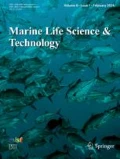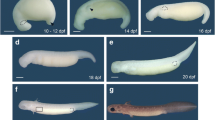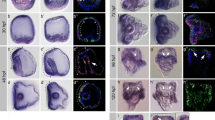Abstract
Seahorses are a hallmark of specialized morphological features due to their elongated prehensile tail. However, the underlying genomic grounds of seahorse tail development remain elusive. Herein, we evaluated the roles of essential genes from the Wnt gene family for the tail developmental process in the lined seahorse (Hippocampus erectus). Comparative genomic analysis revealed that the Wnt gene family is conserved in seahorses. The expression profiles and in situ hybridization suggested that Wnt5a, Wnt8a, and Wnt11 may participate in seahorse tail development. Like in other teleosts, Wnt5a and Wnt11 were found to regulate the development of the tail axial mesoderm and tail somitic mesoderm, respectively. However, a significantly extended expression period of Wnt8a during seahorse tail development was observed. Signaling pathway analysis further showed that Wnt8a up-regulated the expression of the tail axial mesoderm gene (Shh), while interaction analysis indicated that Wnt8a could promote the expression of Wnt11. In summary, our results indicate that the special extended expression period of Wnt8a might promote caudal tail axis formation, which contributes to the formation of the elongated tail of the seahorse.






Similar content being viewed by others
References
Agathon A, Thisse C, Thisse B (2003) The molecular nature of the zebrafish tail organizer. Nature 424:448–452
Aires R, Dias A, Mallo M (2018) Deconstructing the molecular mechanisms shaping the vertebrate body plan. Curr Opin Cell Biol 55:81–86
Andre P, Song H, Kim W, Kispert A, Yang YZ (2015) Wnt5a and Wnt11 regulate mammalian anterior-posterior axis elongation. Development 142:1516–1527
Angers S, Moon RT (2009) Proximal events in wnt signal transduction. Nat Rev Mol Cell Bio 10:468–477
Ashley-Ross MA (2002) Mechanical properties of the dorsal fin muscle of seahorse (Hippocampus) and pipefish (Syngnathus). J Exp Zool 293:561–577
Benazeraf B, Pourquie O (2013) Formation and segmentation of the vertebrate body axis. Annu Rev Cell Dev Biol 29:1–26
Cambray N, Wilson V (2002) Axial progenitors with extensive potency are localised to the mouse chordoneural hinge. Development 129:4855–4866
Carroll SB, Grenier JK, Weatherbee SD (2001) From DNA to diversity: molecular genetics and the evolution of animal design. Blackwell Science, Malden
Cha SW, Tadjuidje E, Tao Q, Wylie C, Heasman J (2008) Wnt5a and Wnt11 interact in a maternal Dkk1-regulated fashion to activate both canonical and non-canonical signaling in Xenopus axis formation. Development 135:3719–3729
Cha SW, Tadjuidje E, White J, Wells J, Mayhew C, Wylie C, Heasman J (2009) Wnt11/5a complex formation caused by tyrosine sulfation increases canonical signaling activity. Curr Biol 19:1573–1580
Charrier JB, Teillet MA, Lapointe F, Le Douarin NM (1999) Defining subregions of Hensen’s node essential for caudalward movement, midline development and cell survival. Development 126:4771–4783
Cho SJ, Vallès Y, Giani JVC, Seaver EC, Weisblat DA (2010) Evolutionary dynamics of the wnt gene family: a lophotrochozoan perspective. Mol Biol Evol 27:1645–1658
Correia KM, Conlon RA (2001) Whole-mount in situ hybridization to mouse embryos. Methods 23:335–338
Cunningham TJ, Kumar S, Yamaguchi TP, Duester G (2015) Wnt8a and Wnt3a cooperate in the axial stem cell niche to promote mammalian body axis extension. Dev Dyn 244:797–807
Duncan RN, Samin P, Tatjana P, Dorsky RI (2015) Identification of wnt genes expressed in neural progenitor zones during zebrafish brain development. PLoS ONE 10:e0145810
Erter CE, Wilm TP, Basler N, Wright CVE, Solnica-Krezel L (2001) Wnt8 is required in lateral mesendodermal precursors for neural posteriorization in vivo. Development 128:3571–3583
Garriock RJ, Warkman AS, Meadowsn SM, D’Agostino S, Krieg PA (2007) Census of vertebrate Wnt genes: isolation and developmental expression of Xenopus Wnt2, Wnt3, Wnt9a, Wnt9b, Wnt10a, and Wnt16. Dev Dyn 236:1249–1258
Gont LK, Steinbeisser H, Blumberg B, Derobertis EM (1993) Tail formation as a continuation of gastrulation: the multiple cell-populations of the Xenopus tailbud derive from the late blastopore lip. Development 119:991–1004
Hale ME (1996) Functional morphology of ventral tail bending and prehensile abilities of the seahorse, Hippocampus kuda. J Morphol 227:51–65
Harlin-Cognato A, Hoffman EA, Jones AG (2006) Gene cooption without duplication during the evolution of a male-pregnancy gene in pipefish. Proc Natl Acad Sci USA 103:19407–19412
Hino H, Nakanishi A, Seki R, Aoki T, Yamaha E, Kawahara A, Shimizu T, Hibi M (2018) Roles of maternal wnt8a transcripts in axis formation in zebrafish. Dev Biol 434:96–107
Hoppler S, Brown JD, Moon RT (1996) Expression of a dominant-negative Wnt blocks induction of MyoD in Xenopus embryos. Genes Dev 10:2805–2817
Hopwood ND, Pluck A, Gurdon JB (1989) MyoD expression in the forming somites is an early response to mesoderm induction in Xenopus embryos. EMBO J 8:3409–3417
Huelsken J, Birchmeier W (2001) New aspects of Wnt signaling pathways in higher vertebrates. Curr Opin Genet Dev 11:547–553
Inohaya K, Takano Y, Kudo A (2010) Production of Wnt4b by floor plate cells is essential for the segmental patterning of the vertebral column in medaka. Development 137:1807–1813
Iwamatsu T (2004) Stages of normal development in the medaka Oryzias latipes. Mech Dev 121:605–618
Kestler HA, Kuhl M (2008) From individual Wnt pathways towards a Wnt signalling network. Philo Trans R Soc B 363:1333–1347
Kimmel CB, Ballard WW, Kimmel SR, Ullmann B, Schilling TF (1995) Stages of embryonic development of the zebrafish. Dev Dyn 203:253–310
Klaus A, Birchmeier W (2008) Wnt signalling and its impact on development and cancer. Nat Rev Cancer 8:387–398
Krausova M, Korinek V (2014) Wnt signaling in adult intestinal stem cells and cancer. Cell Signal 26:570–579
Lekven AC, Thorpe CJ, Waxman JS, Moon RT (2001) Zebrafish wnt8 encodes two wnt8 proteins on a bicistronic transcript and is required for mesoderm and neurectoderm patterning. Dev Cell 1:103–114
Li CY, Li YX, Qin G, Chen ZL, Qu M, Zhang B, Han X, Wang X, Qian PY, Lin Q (2020) Regulatory role of retinoic acid in male pregnancy of the seahorse. Innov 1:100052
Lin Q, Fan SH, Zhang YH, Xu M, Zhang HX, Yang YL, Lee AP, Woltering JM, Ravi V, Gunter HM, Luo W, Gao ZX, Lim ZW, Qin G, Schneider RF, Wang X, Xiong PW, Li G, Wang K, Min JM et al (2016) The seahorse genome and the evolution of its specialized morphology. Nature 540:395–408
Livak KJ, Schmittgen TD (2001) Analysis of relative gene expression data using real-time quantitative PCR and the \(2^{{ - \Delta \Delta C_{{\text{T}}} }}\) method. Methods 25:402–408
Lourie SA, Foster SJ, Cooper EWT, Vincent ACJ (2004) A guide to the identification of seahorses. Project Seahorse and TRAFFIC North America, Washington D.C.
Lu FI, Thisse C, Thisse B (2011) Identification and mechanism of regulation of the zebrafish dorsal determinant. Proc Natl Acad Sci USA 108:15876–15880
Makita R, Mizuno T, Koshida S, Kuroiwa A, Takeda H (1998) Zebrafish wnt11: pattern and regulation of the expression by the yolk cell and no tail activity. Mech Dev 71:165–176
Martin BL, Kimelman D (2008) Regulation of canonical Wnt signaling by Brachyury is essential for posterior mesoderm formation. Dev Cell 15:121–133
Martin BL, Kimelman D (2012) Canonical Wnt signaling dynamically controls multiple stem cell fate decisions during vertebrate body formation. Dev Cell 22:223–232
Moon RT, Brown JD, Torres M (1997) WNTs modulate cell fate and behavior during vertebrate development. Trends Genet 13:157–162
Negishi T, Nagai Y, Asaoka Y, Ohno M, Namae M, MitaniH ST, Shimizu N, Terai S, Sakaida I, Kondoh H, Katada T, Furutani-Seiki M, Nishina H (2009) Retinoic acid signaling positively regulates liver specification by inducing wnt2bb gene expression in medaka. Hepatology 51:1037–1045
Nelson WJ, Nusse R (2004) Convergence of Wnt, β-catenin, and cadherin pathway. Science 303:1483–1487
Neutens C, Adriaens D, Christiaens J, De-Kegel B, Dierick M, Boistel R, Hoorebeke LV (2014) Grasping convergent evolution in syngnathids: a unique tale of tails. J Anat 224:710–723
Novelli B, Ferrer FO, Socorro JA, Dominguez LM (2018) Early development of the longsnout seahorse Hippocampus reidi (Syngnathidae) within the male brood pouch. J Fish Biol 92:1975–1984
Nusse R (2001) An ancient cluster of Wnt paralogues. Trends Genet 17:443
Nusse R (2008) Wnt signaling and stem cell control. Cell Res 18:523–527
Ober EA, Verkade H, Field HA, Stainier DYR (2006) Mesodermal Wnt2b signalling positively regulates liver specification. Nature 442:688–691
Porter MM, Adriaens D, Hatton RL, Meyers MA, Mckittrick J (2015) Why the seahorse tail is square. Science 349:aaa6683
Praet T, Adriaens D, Van-Cauter S, Masschaele B, De-Beule M, Verhegghe B (2012) Inspiration from nature: dynamic modelling of the musculoskeletal structure of the seahorse tail. Int J Numer Method Biomed Eng 28:1028–1042
Prud’homme B, Lartillot N, Balavoine G, Adoutte A, Vervoort M (2002) Phylogenetic analysis of the Wnt gene family: insights from lophotrochozoan members. Curr Biol 12:1395–1400
Ramel MC, Buckles GR, Baker KD, Lekven AC (2005) WNT8 and BMP2B co-regulate non-axial mesoderm patterning during zebrafish gastrulation. Dev Biol 287:237–248
Reya T, Clevers H (2005) Wnt signalling in stem cells and cancer. Nature 434:843–850
Ryan JF, Baxevanis AD (2007) Hox, Wnt, and the evolution of the primary body axis: insights from the early-divergent phyla. Biol Direct 2:37
Saito-Diaz K, Chen TW, Wang XX, Thorne CA, Wallace HA, Page-McCaw A, Lee E (2013) The way Wnt works: components and mechanism. Growth Factors 31:1–31
Shimizu T, Bae YK, Muraoka O, Hibi M (2005) Interaction of Wnt and caudal-related genes in zebrafish posterior body formation. Dev Biol 279:125–141
Sommer S, Whittington CM, Wilson AB (2012) Standardised classification of pre-release development in male-brooding pipefish, seahorses, and seadragons (Family Syngnathidae). BMC Dev Biol 12:39
Song H, Kispert A, Yang YZ (2008) Redundant function of Wnt5a and Wnt11 in somitogenesis and anteroposterior axis elongation. Dev Biol 319:584–585
Tada M, Smith JC (2000) Xwnt11 is a target of Xenopus Brachyury: regulation of gastrulation movements via Dishevelled, but not through the canonical Wnt pathway. Development 127:2227–2238
Thorpe CJ, Weldinger G, Moon RT (2005) Wnt/β-catenin regulation of the Sp1-related transcription factor sp5l promotes tail development in zebrafish. Development 132:1763–1772
Wagner GP, Lynch VJ (2010) Evolutionary novelties. Curr Biol 20:48–52
Welscher P, Zuniga A, Kuijper S, Drenth T, Goedemans HJ, Meijlink F, Zeller R (2002) Progression of vertebrate limb development through SHH-mediated counteraction of GLI3. Science 298:827–830
Whittington CM, Griffith OW, Qi WH, Thompson MB, Wilson AB (2015) Seahorse brood pouch transcriptome reveals common genes associated with vertebrate pregnancy. Mol Biol Evol 32:3114–3131
Wiese KE, Nusse R, van-Amerongen R (2018) Wnt signalling: conquering complexity. Development 145:dev165902
Yamaguchi TP, Bradley A, Mcmahon AP, Jones S (1999) A Wnt5a pathway underlies outgrowth of multiple structures in the vertebrate embryo. Development 126:1211–1223
Zhang YH, Ravi V, Qin G, Dai H, Zhang HX, Han FM, Wang X, Liu YH, Yin JP, Huang LM, Venkatesh B, Lin Q (2020) Comparative genomics reveal shared genomic changes in syngnathid fishes and signatures of genetic convergence with placental mammals. Natl Sci Rev 7:964–977
Acknowledgements
This work was supported by the K.C.Wong Education Foundation, the National Natural Science Foundation of China (nos. 41825013, 41706178, 41576145, 41806189, 32000350), the China postdoctoral science foundation grant (no. 2019M663151), the Guangdong Special Support Program of Youth Scientific and Technological Innovation (2017TQ04Z269). We are also grateful to Wenqi Hu for help with cell culture.
Author information
Authors and Affiliations
Contributions
QL and BZ designed the study, performed laboratory protocols, and analyzed bioinformatics. BZ, GQ and YHZ prepared the tables and figures. BZ and CYL carried out the qRT-PCR and in situ hybridization analysis. LLQ and CLC helped with the experiments. All authors read and approved the final manuscript.
Corresponding author
Ethics declarations
Conflict of interest
The authors declare no conflicts of interest.
Animal and human rights statement
This article does not contain any studies with human participants. All animal experiments were conducted in accordance with established guidelines and approved by the Chinese Academy of Sciences (IACUC #160413).
Additional information
Edited by Jiamei Li.
Supplementary Information
Below is the link to the electronic supplementary material.
Rights and permissions
About this article
Cite this article
Zhang, B., Qin, G., Qu, L. et al. Wnt8a is one of the candidate genes that play essential roles in the elongation of the seahorse prehensile tail. Mar Life Sci Technol 3, 416–426 (2021). https://doi.org/10.1007/s42995-021-00099-7
Received:
Accepted:
Published:
Issue Date:
DOI: https://doi.org/10.1007/s42995-021-00099-7




